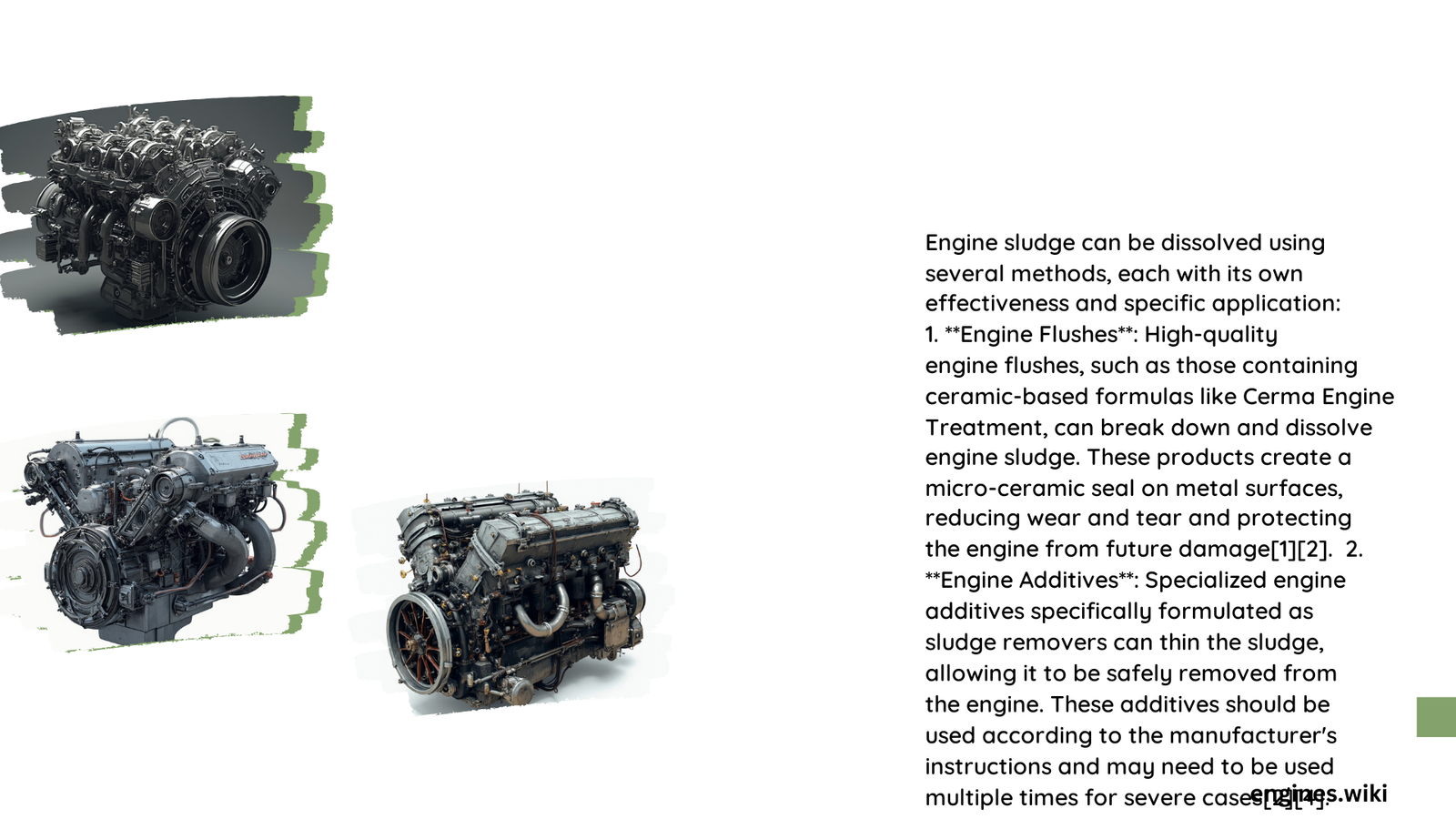Engine sludge, a persistent problem in many vehicles, can be effectively dissolved using a combination of solvents, detergents, and emulsifiers. These components work together to break down and remove stubborn deposits, restoring engine performance and efficiency. This article explores the various solutions available for dissolving engine sludge, their effectiveness, and proper application methods.
What Are the Key Components in Engine Sludge Removers?
Engine sludge removers typically contain a blend of powerful ingredients designed to tackle tough deposits:
- Solvents: These include:
- Glycol monoalkyl ethers
- Methyl amyl acetate
-
Chlorinated hydrocarbon compounds (e.g., chlornaphthalene, chlortoluene)
-
Detergents: Specialized cleaning agents that help break down and disperse sludge particles.
-
Emulsifiers: These components help stabilize the mixture of oil and dissolved sludge, preventing redeposition.
Which Commercial Products Are Most Effective for Dissolving Engine Sludge?

Several commercial products have proven effective in dissolving engine sludge:
- Liqui Moly Pro-Line Engine Flush:
- Highly concentrated formula
- Contains powerful solvents and detergents
-
Designed for professional use
-
AMSOIL Engine and Transmission Flush:
- High concentration of detergents
- Cleans at the molecular level
-
Prevents large debris chunks from causing damage
-
Liqui Moly Sludge Remover:
- Less concentrated than Pro-Line Engine Flush
- Suitable for regular maintenance
- May require multiple applications for severe sludge buildup
| Product | Concentration | Best For |
|---|---|---|
| Liqui Moly Pro-Line Engine Flush | High | Professional use, severe sludge |
| AMSOIL Engine and Transmission Flush | High | Thorough cleaning, preventing debris damage |
| Liqui Moly Sludge Remover | Moderate | Regular maintenance, mild sludge |
How Do Engine Oil Additives Contribute to Sludge Dissolution?
Engine oil additives play a crucial role in sludge prevention and removal:
- Chemical Flushing Additives:
- Contain detergents and emulsifiers
- Help dissolve and remove sludge, varnish, and other insolubles
-
Added to oil during regular maintenance
-
Active Ingredients:
- Detergents: Break down sludge particles
-
Emulsifiers: Keep dissolved sludge in suspension
-
Usage Recommendations:
- Add to engine oil before an oil change
- Run engine at idle for specified time (usually 10-15 minutes)
- Drain oil and replace filter to remove dissolved sludge
What Is the Step-by-Step Process for Dissolving Engine Sludge?
Follow these steps to effectively dissolve engine sludge:
- Preparation:
- Warm up the engine to operating temperature
-
This helps the solvents and detergents work more effectively
-
Application:
- Add the chosen engine flush product to the oil filler port
-
Follow manufacturer’s instructions for quantity
-
Circulation:
- Run the engine at idle for 10-15 minutes
-
This allows the flush to circulate and dissolve sludge
-
Drainage:
- Drain the engine oil completely
-
Replace the oil filter
-
Refill:
- Add fresh oil that meets engine specifications
-
Use a high-quality oil to help prevent future sludge buildup
-
Monitoring:
- Check for any leaks or unusual noises
- Monitor oil condition more frequently after a flush
What Are the Potential Challenges in Dissolving Engine Sludge?
While dissolving engine sludge can greatly improve engine performance, there are some challenges to consider:
- Seal Issues:
- Removing sludge may expose underlying seal problems
-
This can lead to oil leaks, especially in older engines
-
Effectiveness in Severe Cases:
- Very old engines with extensive sludge buildup may not respond well to chemical treatments
-
Mechanical cleaning might be necessary in extreme cases
-
Lubricant Performance:
- Residual flushing fluid can affect the performance of new oil
-
May impact demulsibility and foaming properties
-
Cost Considerations:
- Multiple applications may be necessary for severe sludge
- Professional services can be expensive but may be required for complex cases
How Much Does Engine Sludge Removal Cost?
The cost of engine sludge removal can vary depending on the method and severity:
- DIY Chemical Flush:
- Engine flush products: $10 – $30 per application
-
May require multiple applications
-
Professional Services:
- Basic engine flush: $50 – $100
- Comprehensive cleaning: $100 – $200+
-
Costs may increase for luxury or high-performance vehicles
-
Mechanical Cleaning:
- For severe cases: $200 – $500+
- May involve partial engine disassembly
| Method | Cost Range | Best For |
|---|---|---|
| DIY Chemical Flush | $10 – $90 | Regular maintenance, mild sludge |
| Professional Flush | $50 – $200+ | Moderate to severe sludge, older engines |
| Mechanical Cleaning | $200 – $500+ | Extreme sludge buildup, engine overhauls |
By understanding what dissolves engine sludge and following proper cleaning procedures, vehicle owners can effectively maintain their engines and prevent performance issues related to sludge buildup. Regular maintenance and the use of high-quality oils can also help prevent sludge formation in the first place, saving time and money in the long run.
References:
1. Patent for Cleaning Composition for Removing Sludge from Internal Combustion Engines
2. Removing Sludge, Carbon and Oxide Insolubles, and Varnish from Industrial Lubricants
3. Is an Engine Flush Good or Bad? – AMSOIL Blog
